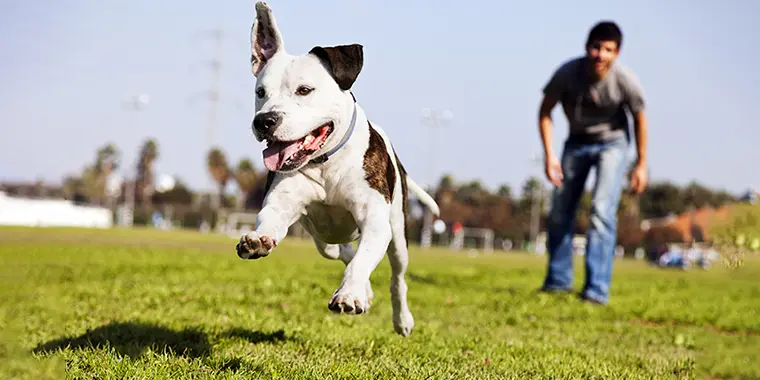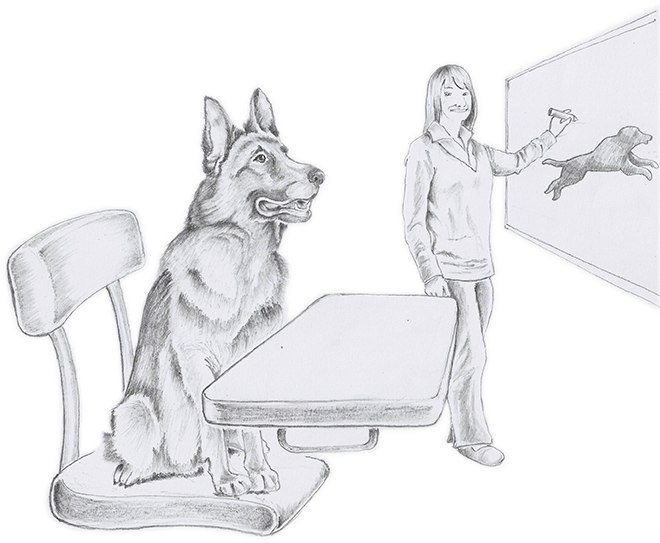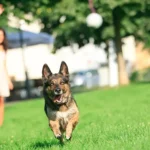
To build your dog up means teaching your dog what you need him to know first. You are a team. Be your dog’s coach. Providing clarity and building trust is what makes your relationship strong.
In 2019, a couple attended our advanced dog socialization with a Labrador Retriever. He was wearing—and was trained with—an e-collar by one of the larger dog training franchises. We only have dogs on regular flat collars in the socials, so I removed all the training equipment and clipped the dog to a long line. This is how we let new dogs interact with other dogs at first. He just sat there, not knowing what to do. He was waiting for his next order and was uncertain about what else to do.
There was no command to follow. So, he just sat there … He was clearly afraid to do the “wrong” thing and get punished for it. This is how he was trained. This is how his owners managed him with the e-collar. It was sad to see because I understand how this behavior was created. What made it even more disturbing was the owners liked him not doing anything. It was their idea of a well-behaved dog. They called it “strong obedience.”
Emotions Drive Behavior
Imagine if this was a child on a playground acting in this manner. Other parents would be alarmed. Someone would keep an eye on these people and eventually call child protective services to report this unusual behavior. They would suspect child abuse. Some of you are now thinking, “hold on,” a dog is not a child, and he is anthropomorphizing the dog. I assure you I am not. Anthropomorphizing is attributing human characteristics or behavior to an animal (or object) it doesn’t have. This shut-down behavior is driven by fear. The limbic system regulates fear in the brain. All mammals have that limbic system. As a result, there is no such thing as a distinct human emotion. Let that sink in.
Emotions: The Brain’s Limbic System
The limbic system is below the brain’s neocortex, and below the neocortex, we are not that special. Affective neuroscience has established this conclusively. This is not an opinion or debate topic. It is an established scientific fact. One either understands it or doesn’t. All mammals have the same emotions. A mouse, a horse, a cat, a dog, and a human; there is no difference in that aspect. However, the expression of emotions varies by species. For example, humans tend not to bite when they get scared, while dogs often do. Also, dogs don’t reason themselves into or out of emotions like humans can and frequently do. But the internal experience is the same, and some external responses—like shutting down as a result of fearing the uncertain consequences of acting—are very similar, and some are identical.
Fear of Acting Isn’t Obedience
The behavior the dog displayed was far from normal. It also had nothing to do with obedience. It was a pure, fear-based behavior, and it should trouble us with dogs as much as it troubles us with children. We are responsible for the care of our dogs. Scaring dogs into submission until they stop moving or doing anything out of fear of punishment is not defensible. Unfortunately, this is way too common.
But to be clear, this isn’t an argument against punishment—which sometimes is necessary for dogs, just like it sometimes is necessary for people. It is an argument against inappropriate punishment. That is the real problem. Konrad Most even pointed this out in his book Dog Training: A Manual, written in 1910!
Erroneous application of compulsion is a deeply rooted evil in training.
– Konrad Most, 1910
Of course, the dog owners are the ones who took this approach with their dog, but they weren’t uncaring monsters. They didn’t know better. They felt they were acting responsibly by controlling their dog’s every action. I also doubt the owners got these ideas on their own. Someone helped shape their way of thinking about their dog.
The 3 Reasons For Misbehavior
Not every dog behavior we don’t like is misbehavior that needs correction. Your dog is not out to get you or get one up on you every chance he gets. Most of the time your dog just doesn’t know better. There are only three possible reasons your dog is not doing what you’re asking:
- Your dog doesn’t (fully) understand what you’re asking.
- He isn’t physically capable of doing what you’re asking (could be temporary)
- Your dog is motivated elsewhere (meaning, not motivated by you)
In all three scenarios, only one party is responsible: YOU, not your dog. Blaming your dog for things out of his control is the opposite of building your dog up.
As a dog trainer friend of mine likes to say:
Your dog is not being a problem. Your dog is having a problem.
– Chad Mackin
How did the view that every unwanted behavior is misbehavior needing fixing get into so many people’s heads? Dog Trainers. Too many trainers fail to build your dog up.
The Experience of the Dog Matters
We have a problem in the dog training industry. It is a pervasive problem, and it runs deep. It is complicated and not easy to resolve. The dog’s experience in training is of no concern to far too many trainers.
We have too many dog trainers who are content with not advancing their skill set. They learned basic dog training skills about suppressing behaviors through compulsion early on and got into the business before they should have. And because most clients don’t know the difference between a calm dog and a dog terrified to make decisions, they have “happy” clients. They got “results.” But what kind of results? A well-behaved dog? Or a dog afraid to do anything because he doesn’t understand what his actions will result in?
Predicting Outcomes of Actions
Imagine how you would feel and act if you couldn’t predict the outcome of your actions any longer. How would you act if any action you took could result in severe punishment? Would you feel helpless? Would you still try to do things? Or would you just shut down, don’t move, and hope that is the right choice? Remember, your dog has the same limbic system as all mammals do. He has emotions, and emotions drive most behaviors.
How did we get here? How did we get to a place where it has become “common wisdom” when a dog doesn’t do as told, it is automatically his fault? And why do we accept the default response to his “misbehavior” to be punishment? We are not in a good place. Dogs deserve better than that. They deserve that we spend the time to build your dog up. As the late Martin Deeley said:
Always give the dog the benefit of the doubt.
– Martin Deeley
Your Dog isn’t Broken
When your air conditioning stops working, you call a repair service to diagnose and fix the problem. If your car makes funny noises, you take it to the shop for repair. When a relationship is in trouble, we seek marriage counseling. When we perceive things as broken, we want someone else to fix them. That has become our thinking. That is how we are raised. That is how we have organized our society.
The common elements are “something needs to be fixed” and “someone else should do it for us.” When your dog is doing things you don’t like, many look at it the same way: “The dog is broken. We need a dog trainer to fix it.”
Next, you hire a dog trainer to discuss and fix your dog’s problems. Here are a few commonly named issues:
- I need my dog to stop jumping on guests or me when I return from work.
- He needs to stop digging holes in the backyard, eating the sprinkler, and so on.
- My dog must return when I call him (meaning, I don’t want him running away in the first place).
- The dog must stop chasing the cat.
- I need my dog to stop barking at strangers.
- And so on.
Poor Advice Leads to Poor Outcomes
As a result, the dog trainer shows up, and you learn that you have been letting your dog get away with things, and you need to step it up and show your dog that you are in charge and start correcting the behaviors you don’t like. Following this approach, some behaviors will stop, some will become less frequent, and some will persist because “he is stubborn.”
However reasonable this approach may seem, it has led to some fundamental problems. Your dog is not broken. The way you have been told to look at his behavior is. You will be more successful if you learn how to build your dog up instead of tearing him down.
Pattern and Relevance
It’s time to realize that you helped create every behavior of your dog you don’t care for. You probably didn’t mean to and may not understand how you could have, but dogs are very smart and highly adaptive. Dogs only engage in behaviors they find rewarding in some way. For example, when you return from work, your dog jumps up at you in excitement. You push him off and scold him—every day. Maybe you even punish him physically, not that you should, but people react. Yet, he keeps doing it. Clearly, your approach is not working. It is entirely possible that pushing your dog off is a fun game in his view. It is an interaction after a boring day at home. You may not see it that way, but your dog may.
The Three Aspects of Reliability
Your dog has detected a rewarding pattern and figured out—on his own—how to get his interaction reward. Everything else is secondary at that point:
- Your dog identified a rewarding thing (the interaction)
- He detected a pattern that led up to it (car in the driveway – footsteps – key in the lock – door opens – jump up – get interaction – yay!)
- Your pooch figured it all out himself.
These are the three elements of reliability, and you repeated that sequence every day, so your dog learned it.
We can use the same three principles ourselves to teach our dog what we want instead, but that is work. Punishing the behavior is much easier and faster. Isn’t it? At least, that’s how it seems at first. However, once you take that path, you discover its limitations quickly. Especially if the behavior is in some way genetically driven, punishment alone won’t help much—this is true for many behaviors you call dog trainers for. Building your dog up will result in a better outcome.
Your Dog is Always Learning
We are teaching our dogs every moment of the day how to interact with us. How to behave when we have dinner—they may get some food. How to behave when the TV is on—opportunity to cuddle on the sofa, and so on. You can teach the right or wrong lessons, but your dog is learning from you constantly. Blaming him for learning what you taught—even if by accident—is unfair.
Teach your dog what you want. Don’t punish him for not being a mind reader. Some dogs are harder to teach than others. It may be beyond your skill set. There is no shame in that. Hire a professional trainer who will not just punish everything right out of the gate. If punishment is necessary, it should be part of a comprehensive training approach. Not the only step. Choose a trainer to help you and your dog become a fantastic team.
Professional dog trainers constantly refine their skillset and will have many different ideas for helping your dog learn. Understanding and correctly applying the principles of canine learning does not happen by watching a few free, simplistic online videos. Acquiring that skill takes years of practice. It costs money. It takes time. This is where the “I do it myself with YouTube” approach will fail you.
The YouTube Problem
Of course, you can find great videos showing you how to lure, shape, and teach basic commands online. YouTube is great for that. Enjoy. But when it comes to addressing challenging behaviors—especially fear and aggression—do yourself and your dog a huge favor and hire professional help. A good trainer will not be cheap, but they won’t be unaffordable either. It will be worth it.
It should be obvious, but popular doesn’t mean good. People with many online followers are not automatically offering great advice because many others like their simplistic ideas. They often offer half-baked approaches that lead nowhere good and don’t care about your dog’s well-being. All they care about are clicks and minutes watched. They make money with every video they post, so they post a lot. Their channel is monetized with ads, which is all they care about. That your dog will suffer in the process is none of their concern. Beware of the self-proclaimed “online experts” who offer only corrections or—on the opposite end—are only throwing more treats at the dog with no rhyme or reason. Dog training requires skill. If someone posts hour-long videos daily, they are not working on being good trainers. They are working on making money with ads.
But How Do I Stop XYZ?
You may agree with me, but you have a dog doing things that must stop. I understand that. No one suggests you ignore all your dog’s behaviors and learn to live with them. I am also not suggesting that punishing a dog for a specific action is never appropriate. We don’t take that approach with each other, and we shouldn’t take it with our dogs. However, I hope you can look at your dog as a friend needing help and not a rebel trying to take over. I am suggesting to you to:
- Teach through PLAY! That alone will transform the relationship with your dog in ways you can’t even imagine until you see it!
- Lay a solid foundation for clear communication without conflict so teaching everything else becomes easier.
- Help your dog learn to make good choices and only manage what you must with one or two solid obedience commands. Ideally, one in motion and one stationary.
- Build your dog’s confidence to reduce the risk of aggressive actions from insecurity.
- Strengthen your dog’s confidence in you by showing him he can trust you 100%.
- Teach your dog what is expected in each environment and situation.
- Hold your dog accountable for what you KNOW he understands fully.
And only after you have done all those things apply a few—APPROPRIATE—punishments here and there when necessary to hold your dog accountable. If you do it fairly and clearly, your dog won’t hold it against you. But, he will stop doing those specific things you taught him not to do.
Motivation, Motivation, Motivation
Once you motivate your dog enough to do what is expected, you will notice that it requires far less punishment to get compliance. Your dog will learn what you want and do it most of the time on his own. That way, motivation stays high, and your relationship becomes stronger. Only use punishment when it is necessary to win against high-value competing motivators in the environment. For example, that pesky squirrel.
This is what I mean by building your dog up. Teach your dog what he needs to know. Be clear in your communication. Motivate the heck out of your dog for the things you want him to do. Only use punishments after all of that, never as the starting point, especially not when dealing with fear-driven behaviors. Ask yourself if you were afraid of something, and instead of getting help, you were slapped in the face. Would that make you less fearful? No, it wouldn’t. Distract you for a moment? Maybe. Build confidence and reduce your fear? Not so much. That is no different for your dog.

Build Your Dog Up with Clear Communication
Most people are very inconsistent in interacting and communicating with their dogs. What do you say “down” to? Only for laying down on the surface, they are on? What do you say “off” to? Is the dog allowed in the kitchen or not? What about the sofa? Is every family member consistent? How you use commands or other cues makes a big difference to your dog. Being clear and consistent in every aspect helps your dog make sense of you and the home. He learns he can trust you. The responses to his actions become predictable. Providing clarity through training builds your dog up.
Build Your Dog Up Through Biological Fulfillment
Dogs are predators, meaning they enjoy all the predatory hunting sequence elements: Searching—Stalking—Chasing—Fighting—Celebrating—Consuming. They don’t just like them; they need these things to be happy. A dog unfulfilled in its basic biological desires will become stressed, reactive, and destructive. If we invite dogs into our homes, we must honor their nature. We must provide outlets for these innate desires, even if only through surrogate activities like games and as part of the training. If our dog is unfulfilled and, as a result, acts up, whose fault is that? It’s not his. Play-based training is a wonderful way of incorporating all aspects of play into training. Fulfilling your dog’s biological needs builds your dog up.
Build Your Dog Up Through Meaningful Reward Events
Learn to understand what motivates your dog. Maybe it is food. It could also be toys or personal play. Your dog decides what is rewarding. Understand it and use it. Make it the most rewarding thing your dog gets for good performance. It will strengthen your relationship, build a closer bond and take your team to the next level. A pat on the head or a piece of kibble is not enough if given in isolation. The more rewarding your interactions are for your dog, the higher your value when competing with a squirrel and wanting your dog’s choice to be your call-off command.
Build Your Dog Up
When you look back at dog training in the 1960s or before, most trainers used a lot of force during training. Pet dogs, movie dogs, or working dogs, it didn’t matter. It was a force palooza all the way. There are still many trainers with this mindset, but things have changed. Since then, we have learned a lot and now understand how to use all training tools, rewards, and punishments with far more sophistication. If you watch old protection sports trials (i.e., Schutzhund) from the early days, you see dogs doing everything in a compliant but unenthusiastic manner.
If you look at the same sport (now called IGP) today, the dogs execute the same or similar routines enthusiastically and joyfully. They look so much happier. Today, you don’t stand a chance of winning in IGP if your dog looks like it was mainly trained through compulsion. Why is that? The dog sport world figured it out much sooner than the pet dog world. The right combination of motivators gives you better performance than harsh punishments alone ever could. That is as true for people as it is for dogs. If you want to, it will be better than if you have to.
Effective Dog Training
Stop accepting compulsion for everything as THE immediate solution to every unwanted behavior. Build your dog up and stop tearing them down by suppressing everything. That isn’t normal. Teach, motivate, and fulfill your dog’s needs and see your relationship flourish. Ask more questions about the training approach when you hire a dog trainer. Do they want to work with an electronic collar (aka, e-collar or shock-collar)? If so, ask them how and let them explain it to you. It’s a great tool to assist in teaching your dog in the right hands. And it’s a horrible tool used to shut your dog down in the wrong hands. Same with prong collars and any other tool. Professional trainers use tools with sophistication and can and gladly will explain every step of training in detail.
All effective training is a combination of reinforcements and punishments, and when you see a skilled professional at work, you should never have a knot in your stomach watching it.
Advocate for your dog! Never let anyone do anything to your dog that feels wrong to you. It doesn’t matter who it is. You are the only advocate your dog has. It is easy to let a trainer in a session or workshop take over and do things to your dog you don’t agree with. They are the expert. It must be okay. No, it isn’t. It is only okay if you say it is ok. I personally never let anyone take the leash of any of my dogs unless I trust them to handle my dogs well. I suggest you do the same.
You and your dog are a team. Be your dog’s coach. Build your dog up!




